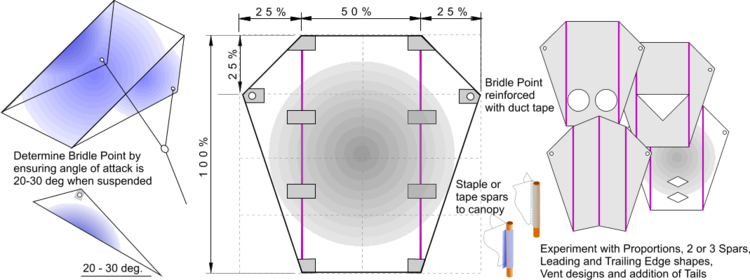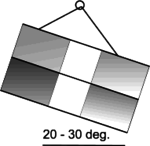Sled Kite Construction
From DT Online
Description
Sled Kites are suitable for most wind conditions but best in steady continuous breezes.
Some general proportions and a basic method of construction is shown opposite.
Note: Once you have finalised your Kite proportions, the Angle of Attack can be set by adjustment of the Bridle. The normal method is to loop the Bridle over one finger and suspend the Kite upside down. The position of the finger is adjusted until the tail of the Kite hangs at an angle of 200 to 300 to the floor.
See the DT Online article on Kite Design Basics for more information about the forces acting on a kite and how to use tails or drogues to balance them.
Materials and Construction
Kites can be made quite successfully using thin Polyethylene sheeting (e.g. as used to make bin liners) and Adhesive Tapes, split Bamboo flower sticks. Kraft Paper can also be used and even Tissue Paper, especially for smaller Kites and using BBQ Skewers for Spars.
More sophisticated Kites, and most commercially available KItes, use Ripstop Nylon or similar, together with Fibreglass Rods and Tubes. Instead of fixing with tape, extra allowances are added to the Kite pattern where needed, to enable the Spars to be slotted into sewn hems.
See the DT Online article on Basic Kite Construction for more detail.
Designer
- Click on the pencil-shaped Edit icon below to show or hide variables and click inside table to alter values (scroll to see all).
- Left or Right click on the screen display or use Scroll Wheel to alter view and Left click on Zoom icon to restore (note: Zoom will be focussed around the cursor position)
- Left click on Download icon and Open with your preferred browser then print screen image from there (useful for trying ideas for text and graphics etc. but unlikely to be actual size), or Save File to create a full-size Scalable Vector Graphics (svg) file which can be loaded into LibreOffice Draw and printed, or graphics software such as Inkscape for eventual output at actual size to a Plotter/Cutter for example. See Packaging Designer User Guide for more detail.
Note:
- The main variable in the table below is the total length of the Kite Spar (set initally to 1200mm)
- Almost all other dimensions are derived as a Percentage of the Spar Length (e.g the total Width, the variable <MaxWidthPercent>, is set initally as equal to the variable <SparLength> - or 100%).
- Parallel Spars are generated by setting the variable <BottomWidthPercent> to be equal to <TopWidthPercent>
- Note that either numbers or <variable names> may be typed in to alter kite proportions
- All Percentages initially are based on the proportions given at the start of this article but all can be changed by clicking in the table and typing in a new Percentage (e.g. the Leading Edge can be straightened by setting the variable <BridleTopPercent> to zero or made pointed by setting to a minus number)
- Refreshing or reloading the page will reset all variables to their default values.
Sled Kite Examples
- To Follow
- To Follow
| [[File:###.png|thumb| ###|link=###]] | [[File:###.png|thumb|###|link=###]] | [[File:###.png|thumb|###|link=###]] |














